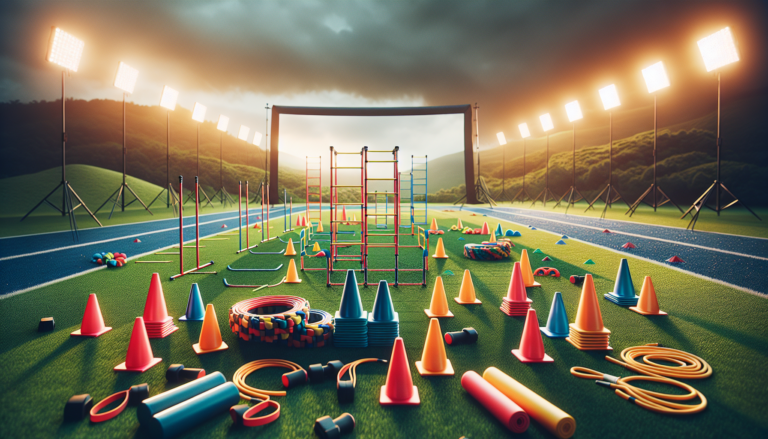Introduction to Agility Training
Agility training has become an essential component of athletic development across various sports, from high school to professional levels. This specialized form of training aims to enhance an athlete’s speed, explosive power, coordination, and specific sports skills. By incorporating targeted exercises and drills, agility training helps athletes gain a competitive edge and excel in their respective fields.
What is Agility Training?
Agility training refers to a set of exercises designed to improve an athlete’s ability to change direction, accelerate, and decelerate quickly and efficiently. It involves rapid, precise, and controlled movements, often in response to external stimuli. Agility training not only enhances physical capabilities but also sharpens mental acuity, as athletes learn to react swiftly to different situations on the field or court.
Benefits of Agility Training
The benefits of agility training extend beyond simply improving an athlete’s speed and coordination. Regular incorporation of agility drills can lead to:
- Increased explosive power, enabling athletes to generate more force in shorter periods
- Enhanced coordination between the mind and body, resulting in more precise movements
- Improved speed and acceleration, crucial for gaining an advantage over opponents
- Reduced risk of injuries due to better body control and balance
- Greater mental alertness and decision-making abilities under pressure
Agility training is what often separates average athletes from exceptional ones. By challenging the body in ways that go beyond the demands of daily life, these exercises help strengthen joints, muscles, and neural pathways, leading to superior athletic performance.
Essential Agility Training Exercises
To reap the benefits of agility training, athletes must incorporate a variety of exercises targeting different aspects of movement. Here are some essential agility training exercises and drills:
Plyometric Hurdles
Plyometric hurdles are an excellent tool for developing explosive power and coordination. Athletes jump over a series of hurdles, focusing on quick, powerful takeoffs and soft landings. This exercise engages the leg muscles, particularly the quads and glutes, while also challenging an athlete’s balance and body control.
Speed Ladder Drills
Speed ladder drills are designed to improve foot speed and coordination. Athletes navigate through a ladder placed on the ground, performing various stepping patterns that require quick and precise foot movements. These drills help develop agility, balance, and rhythm, which translate to better performance on the field or court.
Dot Drills
Dot drills, also known as “five-cone drills,” target the knees and ankles, improving their strength and stability. Athletes move through a pattern of dots or cones placed on the ground, focusing on quick, explosive changes in direction. This exercise enhances an athlete’s ability to pivot, turn, and accelerate rapidly.
Lateral Plyometric Jumps
Lateral plyometric jumps help develop explosive power and balance in the lateral plane of motion. Athletes jump side-to-side over a barrier, aiming for maximum height and minimal ground contact time. This exercise is particularly beneficial for athletes in sports that require quick lateral movements, such as basketball or volleyball.
Forward Running and High-Knee Drills
Forward running and high-knee drills focus on improving foot coordination and speed. Athletes perform high-knee runs, focusing on driving the knees up towards the chest while maintaining a quick and efficient foot strike. These drills help develop proper running form, increase leg power, and enhance overall speed.
Shuttle Runs
Shuttle runs are a classic agility training exercise that combines speed, agility, and endurance. Athletes sprint between two points, touching the ground at each end before turning and running back. This drill simulates the stop-and-go nature of many sports, helping athletes improve their acceleration, deceleration, and change of direction abilities.
Jump Box Drills
Jump box drills target the development of strength and power in the legs. Athletes jump onto and off of a box, focusing on explosive takeoffs and controlled landings. These exercises engage the quads, glutes, and hamstrings, improving an athlete’s jumping ability and overall lower body strength.
L Drills
L drills, also known as cone drills, focus on improving an athlete’s ability to make quick and efficient changes of direction at speed. Athletes sprint forward, backward, and laterally around cones set up in an “L” shape. This exercise simulates game-like situations where rapid changes in direction are required.
Plyometric Agility Drills
Plyometric agility drills combine explosive movements with quick changes of direction. Athletes perform a series of jumps, hops, and bounds, focusing on maintaining proper form while moving swiftly through a designated pattern. These drills help improve overall agility, coordination, and athletic performance.
| Exercise | Key Benefits |
|---|---|
| Plyometric Hurdles | Explosive power, coordination |
| Speed Ladder Drills | Foot speed, coordination |
| Dot Drills | Knee strength, ankle strength |
| Lateral Plyometric Jumps | Explosive power, balance |
| Forward Running and High-Knee Drills | Foot coordination, speed |
| Shuttle Runs | Speed, agility, endurance |
| Jump Box Drills | Strength, power |
| L Drills | Change of direction, speed |
| Plyometric Agility Drills | Explosive movements, performance |
By incorporating these essential agility training exercises into their routines, athletes can develop the skills and attributes necessary for success in their respective sports.
Advanced Techniques and Tools
While traditional agility training exercises form the foundation of athletic development, advanced techniques and tools can take performance to the next level. One such tool is the VertiMax system.
Using VertiMax for Enhanced Training
VertiMax is a resistance training platform that allows athletes to perform agility drills with added resistance. By attaching resistance bands to the athlete’s waist or limbs, VertiMax provides an extra challenge, forcing the muscles to work harder during each movement.
Incorporating VertiMax into agility training offers several benefits:
- Increased resistance leads to greater strength gains
- Improved power output due to the added load on the muscles
- Enhanced coordination and body control as athletes learn to move efficiently against resistance
- Reduced risk of injury by promoting proper form and technique
VertiMax can be used in conjunction with various agility drills, such as lateral plyometric jumps, forward running, and shuttle runs. By progressively increasing the resistance, athletes can continually challenge themselves and push their limits.
Safety and Best Practices
While agility training offers numerous benefits, it is crucial to approach it with safety and best practices in mind. Neglecting proper form or progressing too quickly can lead to injuries that hinder an athlete’s progress.
Importance of Proper Footwear
One of the most critical safety considerations in agility training is wearing proper footwear. Shoes should provide adequate support, stability, and traction to minimize the risk of slips, falls, or ankle injuries. Look for shoes specifically designed for the demands of agility training, with features like lateral support and responsive cushioning.
Gradual Progression in Training
Another key safety principle is to follow a gradual progression in agility training. Athletes should start with basic drills and gradually increase the intensity and complexity as their skills improve. Rushing into advanced exercises without proper preparation can lead to poor form, overexertion, and potential injuries.
It is also essential to allow adequate rest and recovery between training sessions. Agility drills place significant stress on the muscles, joints, and connective tissues, making rest crucial for preventing overuse injuries and promoting optimal performance.
Engagement and Community Interaction
Engaging with the agility training community can enhance an athlete’s learning experience and provide valuable insights for improvement.
Incorporating Feedback into Training Programs
Seeking feedback from coaches, trainers, and fellow athletes is an excellent way to refine agility training techniques. By sharing videos of their drills and asking for constructive criticism, athletes can identify areas for improvement and make necessary adjustments to their form and approach.
Engaging with the community also allows athletes to learn from others’ experiences and discover new exercises or training methods that may benefit their own development. Online forums, social media groups, and in-person workshops provide opportunities for knowledge sharing and growth.
Conclusion
Agility training is a crucial aspect of athletic development that can elevate an athlete’s performance to new heights. By incorporating essential exercises like plyometric hurdles, speed ladder drills, and shuttle runs, athletes can improve their speed, power, coordination, and overall agility.
Recap of Key Points
- Agility training enhances speed, explosive power, and coordination
- Essential exercises target specific aspects of agility, such as foot speed, knee stability, and change of direction
- Advanced tools like VertiMax can provide added resistance for enhanced training effects
- Safety considerations include proper footwear and gradual progression in training
- Engaging with the agility training community offers opportunities for feedback and growth
Final Thoughts on Agility Training
Agility training is a powerful tool for athletes seeking to gain a competitive edge in their sports. By dedicating time and effort to these specialized exercises, athletes can develop the physical and mental attributes necessary for success on the field or court.
However, it is important to approach agility training with a focus on safety, proper form, and gradual progression. By prioritizing these principles and engaging with the training community, athletes can unlock their full potential and achieve their athletic goals.
As the world of sports continues to evolve, agility training will undoubtedly remain a cornerstone of athletic development. Embrace the challenge, stay consistent, and watch your performance soar to new heights.





